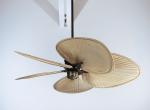Search engine visitors - click here to access entire "$ensible Home" web site
Click here to see a descriptive illustration of several contemporary and traditional ceiling fans.
Dear Jim: I want to get stylish ceiling fans for several rooms. The prices on them vary from $49 to $400. How can I tell which ones are worth it? Will they really cool my house and how much will they save on my bills? - Jo W.

A: There are significant differences in quality, noise level, wobble, air flow, etc., among ceiling fans. When the prices get up into the several-hundred-dollar range, you are also paying extra for unique styling, beautiful flawless finishes and expensive, decorative blade materials.
Ceiling fans do not actually cool a room. They make you feel cooler by creating a breeze. With air flowing over your skin, you feel as comfortable at 75 degrees as in still air at 70 degrees. By setting the air conditioner thermostat higher, the electricity savings can be as high as 25 percent.
You will probably want a quiet one (some cheap ones hum) for a bedroom or living room. An expensive decorative one might also be a good choice for a living room. In other rooms, such as a children's playroom, work areas, etc., low-cost, standard fans purchased from a discount store are adequate.
When selecting your stylish, high-quality ceiling fan, there are important design features to consider. These include the motor, blade material and pitch (twist), speed ranges, and sound/vibration reducing features. Most ceiling fans costing $400 or more will incorporate most of these design features, but you can also find them on some cheaper ones.
A large motor with a cast iron housing is better than a stamped steel one. The extra weight of the cast iron improves stability and controls heat buildup. Some of the best large motors use about 2,200 feet of copper wire, so this explains the higher cost.
Sealed motor bearings are the best. A rubber-mounted hub, where the blades attach, reduces sound and vibration.
A greater blade pitch moves more air at a lower fan speed. This reduces noise and wobble. Also, on high speed, it will create a stronger breeze than a cheaper fan with little blade pitch. Fans with greater blade pitch also often use a more powerful, heavy motor. Look for a fan with a slow low-speed setting. You will use this in the reverse rotation during winter.
There are some new stylish ceiling fans with built-in heaters and thermostats. These are ideal if you have some rooms which are always chilly during winter or rooms which you use only occasionally. For better indoor air quality and less dust, some models have air filters built into the blades.
Many of the high-quality fans have unique designer blades and materials. A high-tech airfoil design is attractive. Others use bi-level blades and leaded glass lights. My favorites are the natural palm and woven bamboo oval blades.
Instant Download Update Bulletin No. 493 - buyer's guide of 11 manufacturers of high-quality, standard and air cleaner ceiling fans listing unique and unusal styles, blade pitch, blade size, blade finishes and colors, speed range (rpm), controls (hand-held or wall-mount), features, many illustrations and features of selected models, a chart showing recommended fan sizes and temperatures for various rooms.
Dear Jim: I am building a new house and I like the idea of radiant floor heating. I also like hardwood flooring, but I do not know if it is compatible with radiant floor heating. Will they work together? - Jack M.
A: Yes they are compatible. The most efficient floor surface for radiant heating is tile, but hardwood is the next best. It is more comfortable to walk on, easy to clean and transfer heat better than carpet.
It is best to choose one of the more size-stable hardwoods such as cherry, ash, maple, and hickory, because of the temperature changes. Using narrow boards, preferably not wider than three inches, works well.